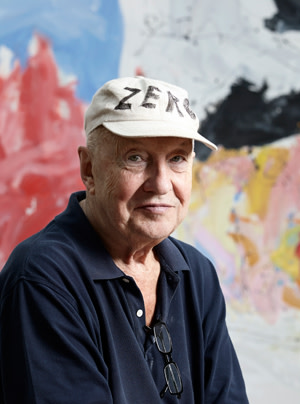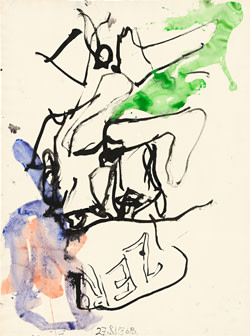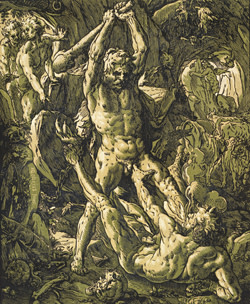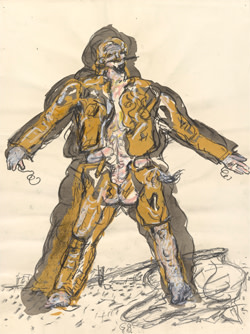Georg Baselitz’s influences and evolution

Simply sign up to the Life & Arts myFT Digest -- delivered directly to your inbox.
When I congratulated Georg Baselitz last month on the opening of two remarkable London shows – top-flight early works on paper in Germany Divided: Baselitz and His Generation at the British Museum, and Farewell Bill, a display at Gagosian Gallery of potent new large-scale paintings – the artist retorted, “No, no, the best is yet to come. Go to the Royal Academy.”
He meant his new exhibition as a collector: over the past half-century he has amassed rare, technically innovative 16th-century prints, which go on display next week in Renaissance Impressions: Chiaroscuro Woodcuts from the Collections of Georg Baselitz and the Albertina, Vienna. Taken together, this trio of exhibitions gives a unique insight into the development of the 76-year-old painter, who has had one of the most unpredictable careers in postwar European art.
Baselitz was not widely known in Britain until his Royal Academy retrospective in 2007. Most gripping at that exhibition were the angry, youthful paintings, evocative of destroyed, morally bankrupt post-Nazi Germany – such as the deformed, ugly masturbator in “The Big Night Down the Drain” and the “Heroes” series, with its lumpen, helpless creatures set in desolate landscapes.
Drawings and prints featuring the hero motif, particularly a group of sumptuously coloured woodcuts, are highlights at the British Museum show, and it is not hard to find inspiration for their extravagant distortions in Renaissance Impressions. Among the great mannerist expressions here are the curling, dynamic lines of Ugo da Carpi’s emotionally charged figure, after Parmigianino, of the eccentric exiled philosopher Diogenes, and the muscular force and crude power conveyed in Hendrick Goltzius’s swelling lines and firmly modelled forms in “Hercules Killing Cacus”, “Oceanus” and “Pluto”.
Except that Baselitz vigorously repudiates any such connection. His art and his art collecting, he insists, are “two absolutely distinct pursuits”, and it is what he considers the “refined otherness” of Renaissance prints that has always appealed to him. Although chiaroscuro woodcuts – a colour work produced by printing two or more woodblocks on top of each other so that gradations of tone suggest volume and depth – began in Germany in the early printing towns of Wittenberg and Augsburg, and Baselitz’s collection contains superb pioneering instances from the 1500s by Cranach (“St Christopher”) and Hans Burgkmair (“St George and the Dragon”), his focus from the start was on the Italian school.

What happened when the chiaroscuro woodcut crossed the Alps – launched in Venice by da Carpi and becoming more fluid and freer in manner in the hands of artists such as Antonio da Trento and Niccolò Vicentino, who made prints after the sinuous, elongated designs of Parmigianino (“Circe and the Companions of Ulysses”, “The Lute Player”, “The Virgin and Child with Saints”) – is a story masterfully told in Renaissance Impressions. Enjoyable as a connoisseur’s show, it is of contemporary interest for the questions it raises about that modernist obsession, the complexity and anxiety of influence.
Baselitz began collecting these prints in the 1960s after a studentship in Florence, a city whose perfectly preserved fabric contrasted with war-ravaged Germany, and at one level the graceful, pristine artifice of mannerism stands in stark opposition to the raw provocations of his own work at this time. Yet mannerism itself was a rebellion – a negation of High Renaissance classical harmony, a search for a deforming expressivity that would allow art to proceed beyond the serene balance of Raphael. Surely Baselitz, as seen in early works at the British Museum such as the scrawled graphite/crayon pink/grey “Dogs” or the flailing, unwieldy, parodic hero of “Partisan”, was encouraged by the exaggerations and compositional instability of mannerism.

Influence is the subject tackled head-on in Baselitz’s latest series, “Farewell Bill”. “Willem raucht nicht mehr” (“Willem’s no longer smoking”) is the original German title of this marvellous homage to abstract expressionist Willem de Kooning, whom Baselitz first encountered in a touring MoMA show, Die neue amerikanische Malerei (New American Painting) in Berlin in 1958. He loved the Jackson Pollocks there too; however, he says that “de Kooning had much greater influence because his painting was European, or of European origin, and its means of depiction were more easily comprehended”.
He has been pondering de Kooning ever since, and has brilliantly assimilated the artist’s impact here in a group of 15 self-portraits that are recognisably Baselitz in their bold, witty, upside-down, don’t-care figuration but are the closest he has yet come to abstraction. Created at Baselitz’s studio on Lake Ammersee, Bavaria, where reflections of the sky in the water can be glimpsed from his window through the trees along the shore, they evoke – in their liquidity and luminosity – the landscapes de Kooning made at Springs, Long Island, in the 1970s.

Although Baselitz’s head, shoulders and cartoon hat, inscribed “Zero”, can be deciphered in most of the paintings, forms dissolve, as they do in de Kooning’s pastoral paintings, in fluid strokes of radiant hues – ripe pinks, corn yellows, vibrant reds, olive greens – and the self-portrait slips, deconstructed, into a colour field. Rapidly applied paint, as light in effect as watercolour, alternates with thicker, more worked areas and spiralling graphic black lines, spattered, dripped, scratched into surfaces that are tense with the physicality of the endeavour.
Footprints and impressions of the rims of paint pots add liveliness, spontaneity: Baselitz works with canvases on the floor, crawling around in them and painting. He says: “Only forms that come directly out of my mind and that cannot be visually controlled …You can’t step back, the way painters do when appraising their picture. I paint abstractly, I don’t paint naturalistically at all.”
He has perhaps been trying, since he turned his motifs upside down in the 1960s, to liberate himself from subject matter. He has finally, triumphantly, done so in Farewell Bill, moving in tone from rapture to self-effacement. In the final painting, bearing the title “Much rat ich wil lent mehr”, a nonsensical anagram of “Willem raucht nicht mehr”, the artist’s features are erased to a ghostly form barely visible beneath feathery white-cream-grey all-over marks.
No postwar German painter – Gerhard Richter, Anselm Kiefer, Sigmar Polke – can be understood outside the context of German political and cultural experience. Yet for all these artists, the weight of German history is limiting as well as stimulating. I was not persuaded by Baselitz’s 2010-11 “Eagle” and “Pioneer” works, musing on themes from reunification to his childhood in east Germany. Farewell Bill seems to me the beginning of a heightened, joyful, surprising old-age style, transcending merely German themes, connecting to global late modernism, and surpassing in painterly flair and emotional register anything he has done for decades.
‘Renaissance Impressions’, Royal Academy, London, March 15-June 8, royalacademy.org.uk
‘Germany Divided: Baselitz and His Generation’, British Museum, London, until August 31, britishmuseum.org
‘Georg Baselitz: Farewell Bill’, Gagosian Gallery, London, until March 29, gagosian.com
Comments